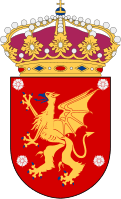Östgöta Air Force Wing
Östgöta Air Force Wing (Swedish: Östgöta flygflottilj), also F 3 Malmslätt, or simply F 3, is a former Swedish Air Force wing with the main base located at Malmen air base near Linköping in south-eastern Sweden.
| Östgöta Air Force Wing | |
|---|---|
| Östgöta flygflottilj | |
 | |
| Active | 1926–1974 |
| Country | Sweden |
| Allegiance | Swedish Armed Forces |
| Branch | Swedish Air Force |
| Type | Corps (1926–1936) Wing (1936–1974) |
| Role | Recon wing (1926–1948) Fighter wing (1948–1974) |
| Part of | First Air Group (1938–1940) Third Air Group (1948–1957) Second Air Group (1957–1966) Eastern Military District (1966–1974) |
| Garrison/HQ | Linköping/Malmslätt |
| Motto(s) | None[note 1] |
| Insignia | |
| Roundel |  |
| Aircraft flown | |
| Fighter | J 1, J 2, J 3, J 5, J 6, J 9, J 11, J 28A, J 29, J 32, J 35 |
| Multirole helicopter | Hkp 3B |
| Reconnaissance | S 1, S 6, S 14, S 16, S 17, S 18, S 22 |
| Trainer | Sk 5, Sk 6, Sk 8, Sk 9, Sk 11, Sk 12, Sk 14, Sk 16, Sk 50 |
| Transport | Tp 5, Tp 52, Tp 79, Tp 83, Tp 85 |
| G 101, Se 102, Se 103, Se 104, A 1, P 1, Ö 1, Ö 3, Ö 4, Ö 6, Ö 9 | |
History
In August 1912, the first pilot school in Sweden was set up at Malmslätt by Carl Gustav Cederström at the location of the 1st Life Grenadier Regiment (I 4). In 1927, that regiment merged with the 2nd Life Grenadier Regiment and moved to new garrisons in Linköping Town to give room for the newly set up 3rd Flying Corps F 3. The name was changed in 1936 to Östgöta Flygflottilj (Östgöta Air Force Wing).
Initially, the corps, or wing, operated the S 1, S 6, S 16, S 17, S 18 and S 22 in reconnaissance squadrons until 1948 when it was converted to a fighter wing by converting the S 22s and replacing other reconnaissance aircraft with three squadrons of J 22s.
In 1950, F 3 received the J 28A from Bråvalla Air Force Wing (F 13) which was replaced rather quickly with J 29As in 1953. Not until 1965 were they in turn replaced by J 35Ds. One squadron was decommissioned in 1970 and the two remaining were converted to J 35Fs.
The two remaining squadrons of J 35F were moved in 1973 to Blekinge Air Force Wing (F 17) when the air wing was decommissioned. The remaining administrative part of the wing was decommissioned in 1974.
The air base was still kept active as a detachment to Bråvalla Air Force Wing (F 13) as F 13 M until 1994, to Uppland Air Force Wing (F 16) as F 16 M until 2003 and now serving as F 17 M to Blekinge Air Force Wing (F 17).
The airfield is known today as Malmen Air Base (ICAO: ESCF). It is currently home to the Swedish Air Force Museum.
Barracks and training areas
The 1st and the 2nd Life Grenadier Regiments' old training area Malmen outside Linköping was taken over and modernized, while the Swedish Air Force Maintenance Depot at Malmslätt (Centrala Flygverkstaden Malmslätt, CFM) retained the parts that belonged to the Aviation Company (Flygkompaniet). The old training heath was the airfield. When the jet fighters were introduced, the first runway was built in an east-west direction. A northbound crossing runway was built in 1969 and became the main runway.[2]
 Chancellery building 1940
Chancellery building 1940 Hospital in 1942
Hospital in 1942 Cadet barracks in 1945
Cadet barracks in 1945 Air Force Maintenance Depot, chancellery and other buildings
Air Force Maintenance Depot, chancellery and other buildings Four Saab 35 Draken's in 1968
Four Saab 35 Draken's in 1968 PS-239 radar in 1972
PS-239 radar in 1972
Heraldry and traditions
Coat of arms
Blazon: "Gules, the provincial badge of Östergötland, a griffin segreant or with dragonwing and tail, armed and langued azure between four roses argent".[3]
Colours, standards and guidons
A colour was presented on 6 June 1939 at F 8 at Barkarby Airport by His Majesty the King Gustaf V. It was transferred to F 13 in 1974 and is today preserved at the Swedish Army Museum.[4] Blazon: "On blue cloth in the centre the badge of the Air Force; a winged two-bladed propeller under a royal crown proper. In the first corner a griffin segreant or with dragonwing and tail, armed and langued gules between four roses argent".[4]
 Colour
Colour
Commanding officers
Commanding officers from 1926 to 1974.[2] The commanding officer was referred to as flottiljchef ("wing commander") and had the rank of colonel.
- 1926–1926: Gösta von Porat
- 1926–1932: Emil Björnberg
- 1932–1934: Axel Gyllenkrok
- 1934–1941: Gösta von Porat
- 1941–1951: Hugo Beckhammar
- 1951–1952: Lennart Peyron
- 1952–1959: Nils-Magnus von Arbin
- 1959–1962: Åke Sundqvist
- 1962–1965: Bengt Rosenius
- 1965–1971: Olof Knutsson
- 1971–1974: Gösta Norrbohm
Names, designations and locations
| Name | Translation | From | To | |
|---|---|---|---|---|
| Tredje flygkåren | 3rd Flying Corps | 1926-07-01 | – | 1936-06-30 |
| Kungl. Östgöta flygflottilj | Royal Östgöta Air Force Wing | 1936-07-01 | – | 1974-06-30 |
| Designation | From | To | ||
| F 3 | 1926-07-01 | – | 1974-06-30 | |
| Location | From | To | ||
| Malmslätt | 1926-07-01 | – | 1974-06-30 |
Footnotes
- The wing had no official motto but often used Carl Cederström's Vilja - våga - vinn ("Will - dare - win").[1]
References
Notes
- Braunstein 2005, p. 52
- Braunstein 2005, p. 53
- Braunstein 2006, p. 58
- Braunstein 2005, pp. 51-52
Print
- Braunstein, Christian (2005). Svenska flygvapnets förband och skolor under 1900-talet (PDF). Skrift / Statens försvarshistoriska museer, 1101-7023 ; 8 [dvs 9] (in Swedish). Stockholm: Statens försvarshistoriska museer. ISBN 9197158488. SELIBR 9845891.CS1 maint: ref=harv (link)
- Braunstein, Christian (2006). Heraldiska vapen inom det svenska försvaret [Heraldry of the Swedish Armed Forces] (PDF). Skrift / Statens försvarshistoriska museer, 1101-7023 ; 9 (in Swedish). Stockholm: Statens försvarshistoriska museer. ISBN 91-971584-9-6. SELIBR 10099224.CS1 maint: ref=harv (link)
Further reading
- Holmström, Stig, ed. (2011). F 3: flygflottiljen på Malmen. Flyghistorisk revy, 0345-3413 ; [Specialnr 2011] (in Swedish). Stockholm: Svensk flyghistorisk förening (SFF). SELIBR 12466276.
External links
| Wikimedia Commons has media related to Östgöta Air Force Wing. |
- Webpage listing all air force squadrons in Sweden (in Swedish)